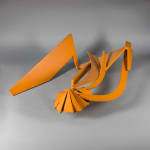Anthony Caro 1924-2013
29 x 72 x 103 cm
Floor Piece Aleph (Flowerhead) (1970) is an example of one of Caro’s ‘floor pieces’, sculptures which demand to be walked around and at times through – thus to be experienced from all four corners of the compass. Caro removed his work ‘down from the plinth’ so they could occupy the space of the viewer, as much as be occupied by the viewer in their encounters with them. The elimination of the base also eliminated the ‘objecthood’ of Caro’s earlier work, whilst his use of bold colours was a means of neutralising the material or surface character of each individual element of a piece bringing them together in unexpected harmony. Essential to Caro’s innovative move away from the plinth was his choice also not to work in bronze as this material held firm associations with ‘fine art’ and not abstractions. His decision to work in steel meant his sculptures were guided by the pre-existing, industrial shapes in which this material was formed – including I-beams, tubes, sheets and grilles.
The floor pieces, therefore, demonstrate the ways in which his configurations were pieced together through improvisation, with each individual element able to be adjusted, changed, or eliminated altogether prior to completion. In their lateral dispersion Caro’s floor pieces are particularly prone to improvisation, as this sculptural perspective offers more freedom and a greater field of play in construction than its vertical counterparts, where each element of the system is key to the support of those above.
This particular piece was owned by Caro’s friend the art critic, Clement Greenberg. In his choice of the burnt orange, Floor Piece Aleph (Flowerhead) radiates a Mediterranean heat that speaks to the emotive power of Caro’s vibrant, strong, but monotone colour application. Floor Piece Aleph (Flowerhead) presents Caro at his best, with the lightness and elegance of form juxtaposed against the heavy-duty nature of his chosen material. This piece also reflects Caro’s tendency to collect ‘bits’ resulting in his peers often referring to him fondly as ‘something of a magpie’ – which can be seen replicated in his larger works.
Provenance
The Artist, from whom acquired by Clement Greenberg, New YorkMiddendorf/Lane Gallery, Washington, D.C.
Dr. Joseph D. Lichtenberg, 30 November 1978
Private collection, France
Literature
Anthony Caro. Table and Related Sculptures 1966-1978 (exh. cat.), Braunschweig, Kunstverein Braunschweig, 1979, illustrated p. 187;
Dieter Blume, Anthony Caro, Catalogue Raisonné, 1966-1978 Vol. I, Table and Related Sculptures 1966-1978, Verlag Galerie Wentzel, Cologne, 1981, no. 100, illustrated p. 187





